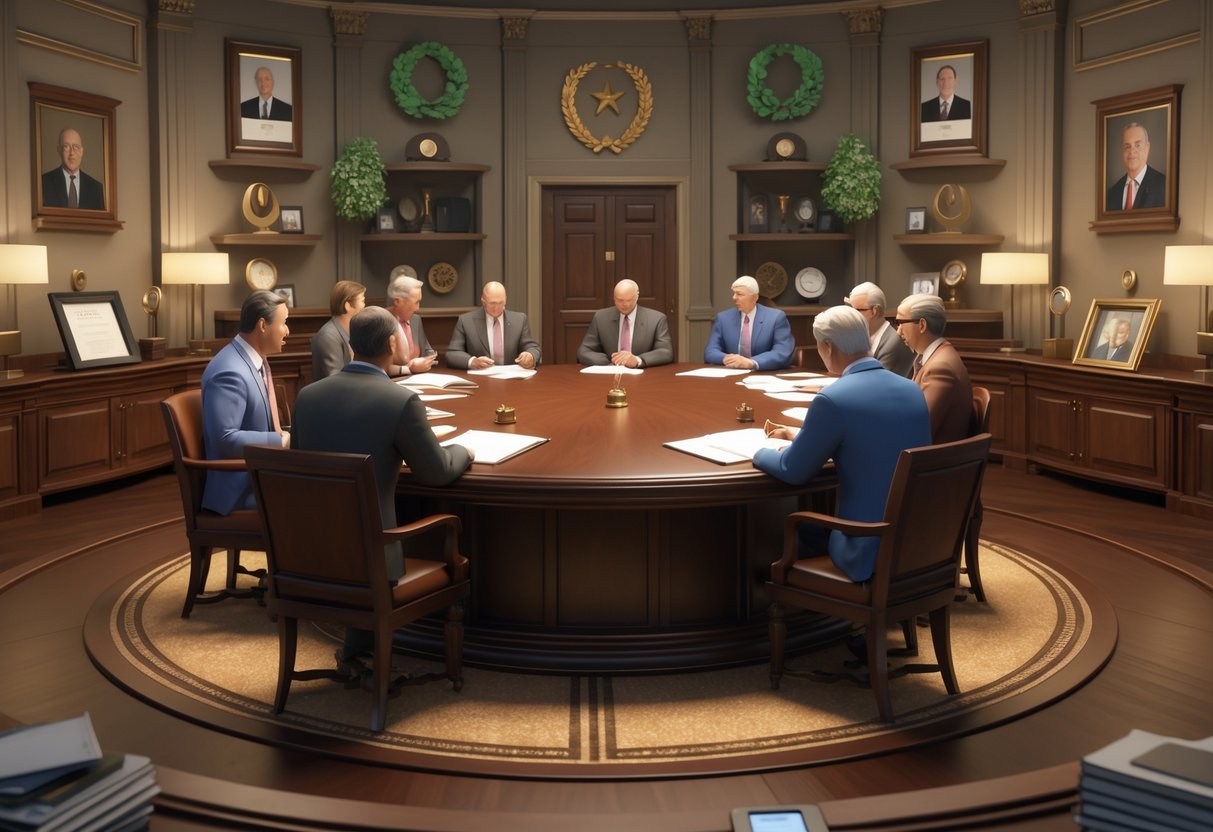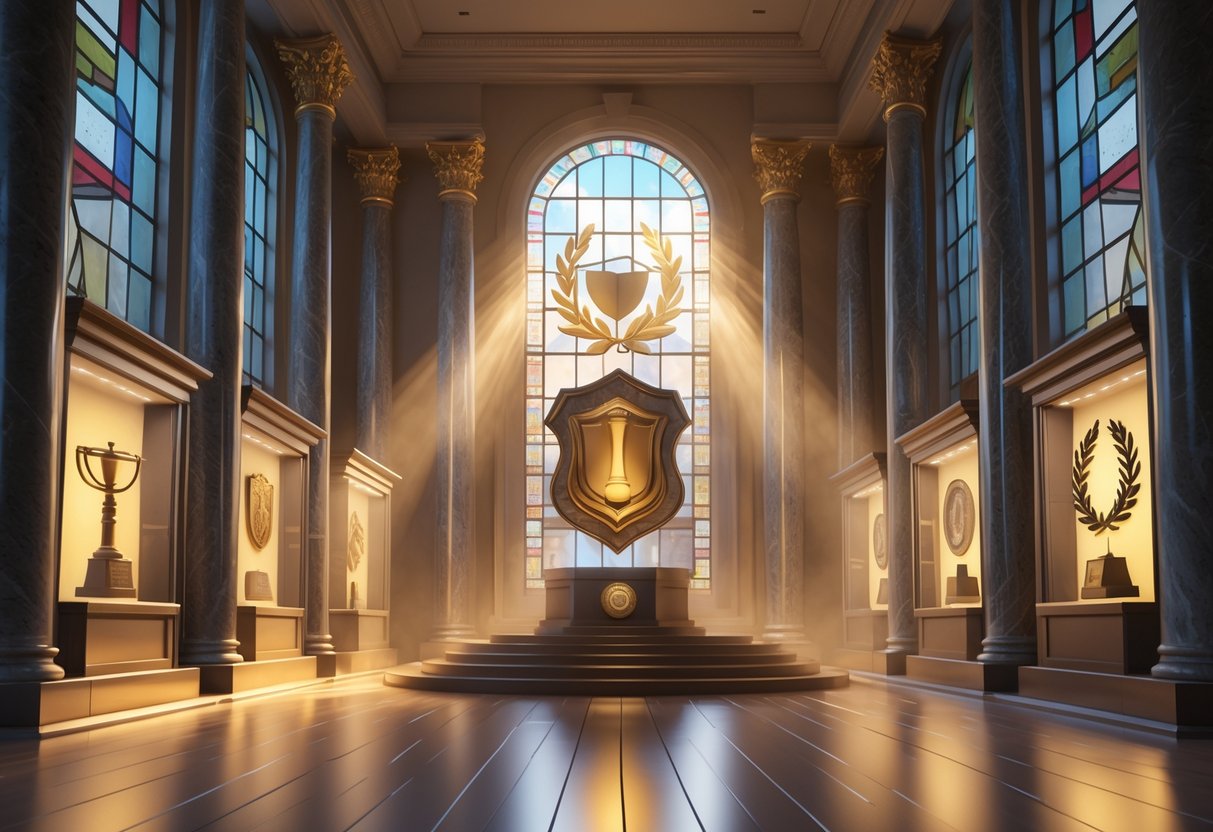Hall of Fame Criteria: Complete Guide to Eligibility & Selection
Updated On: August 24, 2025 by Aaron Connolly
Understanding Hall of Fame Criteria
Hall of fame criteria act as the gatekeepers to sporting immortality. They decide which athletes, coaches, and contributors really deserve permanent recognition.
These standards can look wildly different depending on the sport. Still, you’ll always find common threads—stuff like performance excellence, character, and waiting periods.
Definition of Hall of Fame
A hall of fame stands as the highest honor in any sport. It’s where people who’ve made extraordinary contributions—through playing, coaching, or just pushing the game forward—get remembered forever.
Each hall builds both physical and digital spaces to celebrate their legends. You’ll find artifacts, stats, and stories that keep sporting history alive for anyone who cares to look.
Key characteristics include:
- Permanent recognition status
- Physical display locations
- Strict eligibility requirements
- Voting or selection committees
- Annual induction ceremonies
Most halls want nominees to be retired for a certain amount of time. Baseball players have to wait five years after they hang it up. Football has similar rules, giving everyone time to really evaluate a career.
Committees of experts, journalists, or former players usually handle the selection process. They review candidates and then vote, matching each name against the hall’s rules.
Purpose of Hall of Fame Standards
Hall of fame standards exist to make sure only the most deserving get in. If the bar drops, the honor just doesn’t mean as much.
Primary purposes include:
- Maintaining exclusivity: High standards keep the honor valuable.
- Ensuring objectivity: Clear criteria help cut down on bias.
- Character evaluation: Standards look at behavior on and off the field.
- Historical context: Criteria help compare folks from different eras.
The waiting period lets emotions cool down and gives everyone a better perspective. Voters can look at a player’s impact with a clear head.
Character clauses? Yeah, they’re controversial, but still important. Baseball’s character rule has kept out some statistical giants because of off-field issues. It’s a reflection of what the sport wants to stand for.
Strict standards also protect against hype. They reward people who showed real excellence over time, not just flashes of greatness.
Differences Between Various Halls of Fame
Every sport’s hall of fame mirrors its own culture and values. That’s why the path to immortality looks different in baseball, football, or basketball.
Baseball Hall of Fame asks for ten seasons played and a 75% voting threshold. Players can stay on the writers’ ballot for ten years. Veterans committees sometimes give overlooked folks another shot.
Football halls tend to weigh team success along with stats. The Pro Football Hall of Fame uses a 36-member selection committee and they really dig into debates.
Statistical thresholds? All over the place:
| Sport | Key Requirements | Voting Body |
|---|---|---|
| Baseball | 10 seasons, 5-year wait | Baseball writers |
| Football | 5-year wait | Selection committee |
| Basketball | Varies by level | Mixed committees |
Some halls lean hard on stats, others care more about impact or influence. Basketball, for example, often values international play and coaching achievements more than the others.
The character clause shows up almost everywhere, though it’s stricter in baseball. Other sports might forgive more off-field drama.
Voting processes? No one does it quite the same:
- Some go with simple majority votes.
- Others, like baseball, want a 75% super-majority.
- Committee sizes can be tiny or massive—anywhere from 16 to over 400 voters.
These differences really show what each sport cares about and how they define greatness.
Eligibility Requirements for Induction
Getting into a hall of fame isn’t just about being amazing at your sport. Most halls set tough rules about how long you need to play, when you can retire, and what might keep you out.
Minimum Years of Service
Sports all set their own standards for how long you need to be around before you’re even considered. The NFL, for example, looks for a solid pro career but doesn’t put a specific number on it.
Basketball and American football both want to see consistent greatness, not just one hot season.
Key service requirements include:
- Showing high-level performance year after year
- Contributing big to your team’s success
- Building a career that stands out from the crowd
- Leading both on and off the field
Halls often judge coaches a bit differently. If a coach racks up a bunch of championships in fewer years, that can be enough.
Contributors—owners, journalists, innovators—face the loosest rules. It’s more about impact than years.
Retirement Periods and Waiting Times
You can’t get inducted while you’re still playing. Every major hall of fame sets a waiting period after retirement.
Standard waiting times:
- NFL players: At least 5 years retired
- NBA players: At least 5 years retired
- NFL coaches: Only 1 season of retirement needed
- Contributors: No waiting period at all
This gap lets voters look at careers with a cooler head. It also stops athletes from campaigning for themselves right after leaving the game.
Coaches get a shorter wait because their impact can be obvious sooner. If a coach turns a team around, you usually know it pretty fast.
Disqualifications and Ineligibility
Some actions will shut the hall of fame door for good, though the rules change from sport to sport.
Common disqualifications include:
- Betting on your own team’s games
- Getting banned from the sport for life
- Serious criminal convictions while playing
- Using performance-enhancing drugs (for some halls)
But not every hall treats these things the same. Some are stricter than others about off-field stuff.
Temporary ineligibility can happen too. If you’re suspended, your retirement clock might just stop ticking.
Selection committees have the final word on tricky cases. They weigh a person’s achievements against any negatives.
Contributors and coaches get the same close look. Being great at your job doesn’t erase serious misconduct.
Criteria for Athlete Induction
Esports athletes need to rack up specific achievements and recognition if they want a shot at the hall of fame. Committees look at measurable performance, prestigious awards, and long-term influence on competitive gaming.
Performance Achievements
Winning tournaments and showing consistent high-level play are the foundation for consideration. Most athletes need major championship wins or years of sustained excellence.
Prize earnings give a clear measure. Pros who stack up big winnings across multiple events show they can perform again and again.
Match statistics matter too. Things like kill-death ratios in FPS games, win rates in MOBAs, and clutch plays in big moments all count. We’re looking for people who shine under pressure.
Team success weighs heavily. Players who help teams win major titles or land on the podium consistently show leadership and impact. Individual skill is great, but it means more when it boosts the team.
Most halls want to see at least two years of competitive play. Athletes also have to wait five years after retiring before they’re eligible.
Honours and Awards
Individual honors help separate the best from the very good. MVPs from major tournaments carry a lot of weight.
League recognition—like season MVPs, rookie of the year, or all-star nods—shows respect from peers and experts.
Media awards from gaming outlets or esports journalists add external validation. Player of the year or hall of fame awards from other groups can boost a candidate’s case.
Fan voting in community polls highlights popularity and staying power. Players who keep landing high in fan-favorite lists often have cultural impact that goes beyond pure stats.
Some athletes get lifetime achievement recognition for pioneering efforts in a specific game or the esports world as a whole.
Legacy and Impact
Long-term influence sometimes matters more than stats alone. Committees look at how athletes changed their games and inspired others.
Innovation in tactics or gameplay marks out real legends. If someone invents a new strategy or changes how everyone plays, that stands out.
Mentorship roles after retirement show ongoing commitment. Ex-players who coach or help new talent prove they’re still giving back.
Community building—streaming, content creation, charity work—extends an athlete’s impact way past just competition. Growing the fanbase helps the whole scene.
Cross-game influence matters too. Players who succeed in more than one game show rare adaptability and skill.
Coach Selection Standards
Coach induction standards focus on proven success, leadership, and professional achievement. Each organization sets its own requirements for coaching records, tenure, and recognition after retirement.
Coaching Records and Tenure
Minimum performance standards are key for coach selection. The College Football Hall of Fame wants coaches to have at least 10 years as a head coach and 100 games under their belt.
The winning percentage requirement just changed recently. The National Football Foundation dropped it from .600 to .595 starting with the 2027 ballot. That’s going to open the door for a few more coaches.
Career longevity weighs heavily. Committees want to see coaches succeed over time, not just in a quick burst. The 100-game minimum makes sure candidates have faced ups and downs and kept delivering.
Additional requirements include:
- Head coach for at least 10 seasons
- Minimum .595 winning percentage (College Football Hall of Fame)
- Waiting period after finishing their career
Leadership and Player Development
Character assessment really matters. Committees look at how coaches helped players grow on and off the field. They check things like academics, community work, and how former players do after graduation.
Innovation and strategy get attention too. Coaches who come up with new techniques or training ideas that others adopt stand out. Sometimes, these contributions matter more than the win-loss record.
Mentorship legacy comes up a lot. Committees want to know how many former players or assistants go on to coaching or other big things. That shows the coach’s influence lasts.
The evaluation process takes into account:
- Player graduation rates and academic success
- Testimonials and achievements from former players
- Coaching tree and mentor impact
- Community and institutional involvement
Professional Recognition
Industry acknowledgment gives coaching candidates a real boost. Awards from coaching groups, conference honors, and peer nominations all show respect from the profession. The American Football Coaches Association even gets consulted on some criteria changes.
Retirement timing requirements shift depending on the hall. Most want coaches to be retired for a certain time before they get considered. The College Football Hall of Fame, for example, asks for three full seasons out of the game, unless the coach is 70 or older—then they’re immediately eligible.
Active coach provisions kick in for rare cases. Coaches who hit age 75 while still working can be considered. That’s a nod to those who just keep going.
Professional recognition factors include:
- Conference championships and big tournament runs
- Coaching awards from associations
- Peer nominations and industry backing
- Media recognition and hall of fame buzz
Contributor Nomination Guidelines

Contributors are folks who’ve made a big difference in esports outside of playing or coaching. Nominations for this group need clear proof of achievements and real dedication to pushing competitive gaming forward.
Definition of Contributor
A contributor in esports is anyone who’s pushed competitive gaming forward outside of actually playing. That could mean tournament organisers, broadcasters, journalists, team owners, or technology developers.
Contribution comes in all shapes. If you organise events that pull in thousands of viewers, you’re in. Journalists who get esports into the mainstream definitely count too.
Key contributor roles include:
- Tournament and league organisers
- Broadcast talent and production staff
- Team owners and general managers
- Technology platform developers
- Community builders and content creators
Industry analysts often call contributors the backbone of esports growth. Without organisers, those big tournaments just wouldn’t happen. Broadcasters make sure matches reach fans everywhere.
The contributor label reminds us that esports needs way more than just skilled players. It takes whole ecosystems of dedicated folks to build the tournaments, coverage, and infrastructure that millions tune in for.
Major Contributions to the Sport
Major contributions leave a real mark on esports—something you can measure, not just showing up.
Creating tournaments is a classic example. If you launched an event that turned into an annual tradition, you’ve left a mark. Building leagues that last for years? That’s sustained impact.
Broadcasting matters too. If you pioneered new ways to cover matches or brought esports to fresh audiences, that’s huge. Early streamers who made esports broadcasts feel professional fit here. Commentators who helped viewers actually understand complex games really changed the scene.
Contribution categories we look at:
| Area | Examples | Impact Measure |
|---|---|---|
| Events | Tournament creation | Participant numbers, longevity |
| Media | Broadcasting innovation | Audience growth, industry adoption |
| Technology | Platform development | User adoption, industry standard |
| Business | Team/organisation building | Revenue, player development |
Business contributions can mean building teams that actually last or coming up with ways to keep revenue flowing. Those early franchise owners who proved esports could really work? They made a difference.
Longevity of Service
Longevity depends on what you’ve contributed, but usually, we’re looking for five or more years of active, hands-on involvement. Consistency matters more than just a brief moment in the spotlight.
Tournament organisers need to run several successful events over the years. One big tournament is great, but it doesn’t show the long-term commitment we want.
Broadcasting contributors should show growth and stick around. Commentators who cover major events for years across different games really stand out.
Service duration expectations:
- Event organisers: At least 5 years of running tournaments
- Media professionals: Ongoing coverage over several seasons
- Business leaders: Long-term team or organisation development
- Technology developers: Continued platform growth and support
There’s no waiting period for recent retirees in this category. Contributors can get nominated while they’re still active.
We want to see that nominees truly commit, not just dip in and out. Esports thrives thanks to people who stick around and keep building.
Team-Based Hall of Fame Consideration

Teams get into the hall of fame based on what they achieve together, not just on individual stars. Criteria focus on championship titles, lasting impact on their sport, and meeting certain eligibility timelines.
Championships and Accomplishments
Winning championships is usually the main thing teams get judged on. Most halls require teams to win major titles—league trophies, international tournaments, maybe even Olympic medals.
Key Achievement Categories:
- League Championships: Top domestic titles
- International Victories: World championships, Olympic medals, big continental wins
- Historic Milestones: Record streaks or game-changing performances
The U.S. Olympic & Paralympic Hall of Fame recognises teams alongside individual athletes. Teams need to show top-level excellence to make the cut.
Prize money and tournament wins matter too. Teams that rack up top finishes across different seasons look stronger than one-hit wonders.
Historic Team Impact
Teams also get recognised for how they change their sport or influence others. It’s not just about wins and losses—it’s about cultural impact.
Impact Measures Include:
- Coming up with new strategies or playstyles
- Breaking attendance records or growing the fanbase
- Overcoming big social barriers
- Creating rivalries that push the sport forward
Committees look at whether a team’s influence lasted after they stopped playing. Teams that inspired rule changes, got more people involved, or became household names get extra credit.
Geography matters, too. Teams from regions that don’t usually get much attention might get recognised for growing the sport in new places.
Eligibility Timeframes for Teams
Most halls of fame set waiting periods before teams can be nominated. This gives everyone time to see what their real impact was.
Common Time Requirements:
- Minimum Wait: 5–10 years after the team disbands or core players retire
- Active Status: Teams have to be inactive or changed significantly
- Achievement Window: Some halls only look at the team’s best years
The selection process usually has a few stages. Committees review nominations and narrow things down before voting.
Teams sometimes compete with individuals for limited spots. Some halls keep special slots just for teams so they’re not overlooked.
Role of the Hall of Fame Selection Committee

The Hall of Fame Selection Committee chooses new inductees every year. They follow a structured voting process with strict rules to make sure only the most deserving get in.
Committee Structure and Members
Up to 50 media representatives from across professional football make up the selection committee. Each NFL city gets one spot, with Los Angeles and New York getting two each because they have two teams.
The group includes 17 at-large delegates who add extra expertise. You’ll find former players, coaches, and respected football journalists among them, bringing all sorts of perspectives.
A Pro Football Writers of America rep serves a two-year term. The rest of the committee faces annual review and approval by the Hall of Fame’s Board of Directors.
The committee meets every year before the Super Bowl to pick new members. They review up to 20 finalists, including nominees from special committees for seniors, coaches, and contributors.
Selection Committee Duties
The committee has to look closely at each candidate’s biography and career stats. To get in, a nominee needs at least 80% approval from committee members.
Each year, members vote for four to eight new inductees, following the current bylaws. The 1973 and 1976 classes only had three people each—those were the smallest ever.
Ernst & Young auditors help make sure voting stays fair and accurate. The committee also works with special groups that nominate senior players, coaches, and contributors.
Members handle fan nominations and check whether candidates meet the main requirements. Players must wait five years after retiring and need to have earned honours like Pro Bowl or All-Pro selections.
Nomination and Application Process

Most halls of fame let the public send in nominations, but paperwork and deadlines can be all over the place. Usually, you’ll need to submit detailed nomination forms and supporting materials within a set timeframe.
Who Can Submit Nominations
Pretty much anyone can nominate someone for most halls of fame. You don’t need special qualifications or connections.
The Pro Football Hall of Fame lets any fan nominate players, coaches, or contributors. You just write to them with your pick. The 50-member Selection Committee can nominate people too.
Some specialist halls only take nominations from their members. For example, the NFCA Hall of Fame requires nominators to be members in good standing. Professional groups often keep nominations in-house.
Key points about nominators:
- Most sports halls let the public nominate
- Some require you to be a member
- More than one person can nominate the same candidate
- Previous nominees don’t automatically carry over
Required Documentation
Nomination packets need solid supporting materials. Most places ask for official forms plus extras.
Standard requirements include:
- Completed nomination form with all the biographical details
- Three letters of support from credible sources
- Career stats and achievements with proof
- Impact statements explaining what the nominee has done
Some halls want more. You might need to send:
- Media coverage or press clippings
- Awards and honours lists
- Testimonials from peers or colleagues
- Photos of achievements
Heads up: If your nomination packet isn’t complete, it’ll probably get tossed right away. Double-check everything before sending.
Tell the nominee’s story clearly. Quality matters more than just a pile of documents.
Nomination Deadlines
Deadlines are all over the map. Most halls follow yearly cycles with set cutoff dates.
Common patterns:
- Spring deadlines (March–May) for autumn inductions
- Summer deadlines (June–August) for the next year’s ceremony
- Rolling submissions accepted year-round
- Multiple review cycles with early and final deadlines
The Pro Football Hall of Fame has a set timeline. They send out preliminary lists in June, July, and September. Final selection happens right before the Super Bowl.
Quick tip: As soon as you decide to nominate someone, mark the deadline on your calendar. Late entries usually don’t get a second look.
Some halls let you resubmit if your nominee doesn’t get in. You can update and improve your case for future rounds.
Voting and Evaluation Procedure

Hall of Fame voting runs on strict thresholds and timelines, which differ by sport. Most require 75% of voters to say yes for someone to get in. The process includes several review stages and ballot rules to keep things fair.
Voting Thresholds
Most major sports halls of fame need 75% approval for induction. That’s standard for baseball’s BBWAA, tennis, and a bunch of others.
The Baseball Writers’ Association holds the line—if you get votes on 75% of ballots, you’re in.
Some halls use other thresholds, but 75% pops up a lot.
Voter eligibility isn’t for just anyone. Baseball writers must have ten years of active experience. Other halls set their own requirements.
High thresholds make sure only the truly exceptional get in. That keeps the hall’s reputation strong and avoids lowering the bar.
Ballot Process and Timelines
Baseball handles this with a clear annual schedule. The BBWAA sends out ballots in late November. Voters have until 31st December to send them back.
Voters can pick up to ten candidates. Write-in votes usually aren’t allowed.
A screening committee puts together the ballot. To get on, you need at least 5% support from last year’s voting or a nomination from two committee members if it’s your first time.
| Timeline Stage | Baseball Hall Process |
|---|---|
| Late November | Ballots mailed to voters |
| December | Voting period |
| 31st December | Ballot deadline |
| January | Results announced |
Voters look at playing record, ability, integrity, sportsmanship, character, and team contributions.
Results only go public after both the writers’ association and hall reps sign off.
Review and Appeal Mechanisms
Most halls don’t really offer appeals after voting ends. The nomination and screening stage is where most of the vetting happens.
Baseball gives players up to ten years on the ballot—if they keep getting enough votes.
Ineligible candidates can’t appear on ballots at all. Baseball keeps an ineligible list to block certain players.
The main review happens during nominations. Different committees check out candidates before they ever hit the ballot.
Some halls have different nomination tracks for contributors, veterans, or newly retired players.
Board oversight is standard. The Baseball Hall’s Board of Directors can change voting rules or revoke them anytime.
This setup balances open voting with strong oversight to keep standards high.
Character and Conduct Standards

Hall of Fame criteria go beyond stats and trophies. Inductees need to show strong character and ethical behaviour. They should make a positive impact on their sport and their community.
Code of Ethics
The character clause acts like an invisible wall that can block even the most statistically dominant players from getting in. Voters look at a player’s integrity, sportsmanship, and overall character—both on and off the field.
This standard sparks heated debate, especially around controversial figures. Sometimes, players with amazing stats get rejected because of alleged steroid use or other ethical issues.
Key character considerations include:
- Honesty and integrity in competition
- Respect for opponents and officials
- Adherence to rules and regulations
- Public conduct and behaviour
- Impact on the sport’s reputation
Some voters stick to this clause like glue, excluding any player with character concerns. Others, though, focus more on the numbers and achievements, even if a player has some flaws.
Because there’s no universal standard, similar cases often end up with completely different results. You can see this inconsistency in voting patterns over the years.
Community Contributions
Inductees get judged not just on personal conduct, but also on their positive impact on the sport and the wider community. This might mean mentoring younger players, doing charity work, or helping the sport grow.
A lot of Hall of Famers show leadership by running youth programs, coaching, or even working in sports administration after they retire. These actions usually help their case, showing they’re committed to the sport for the long haul.
Community impact factors include:
- Youth development and coaching
- Charitable foundation work
- Sport promotion and ambassadorship
- Educational initiatives
- Cultural bridge-building
Players who give back to their communities and keep high personal standards tend to get stronger support from voters. This broader approach means the Hall of Fame stands for more than just athletic skill—it highlights role models for the next generation.
Special Categories and Exceptions

Most halls of fame set up special paths for people who don’t fit the usual criteria. These categories help deserving folks get noticed, even if their timing or unique circumstances aren’t typical.
Veterans and Era Committees
Veterans committees exist because regular voting sometimes misses worthy candidates. These groups look back at older players and contributors who might’ve slipped through the cracks.
They usually focus on certain time periods. For example, one committee might dig into candidates from the 1960s or check out early pioneers.
Committee members often include:
- Former players from that era
- Historians and researchers
- Media members who covered those times
- Previous inductees
Selection process looks different from regular voting:
- Smaller groups (usually 10-16 people)
- Different eligibility windows
- Sometimes lower vote thresholds
Veterans committees don’t meet as often as the main voting body. Some gather every three years, but others have their own schedules.
They’ve brought a lot of forgotten careers back into the spotlight. Players who retired before media coverage exploded usually benefit most from this.
Posthumous and Senior Induction Rules
Most halls of fame allow posthumous inductions under specific guidelines. Candidates need to have met eligibility rules while alive, or at least fit the standard criteria even after passing away.
Common posthumous rules include:
- Must have retired for the required period before death
- Can’t be inducted just because they’ve passed away
- Same achievement standards as living candidates
Senior categories honor more than just playing careers. These spots go to coaches, officials, administrators, and other big contributors.
Senior eligibility often means:
- Minimum age (usually 65+)
- Significant service (10-20 years is common)
- Real impact on the sport’s development
Some organizations set up “special merit” categories. These let them skip normal waiting times for truly exceptional situations.
Honestly, posthumous voting can get emotional and drift from merit. The best committees try to keep their standards steady, no matter what.
Frequently Asked Questions

Hall of Fame criteria can change from sport to sport, but most share basics like minimum playing years, waiting periods, and voting thresholds. Baseball’s Hall of Fame probably has the most detailed—and argued over—criteria in pro sports.
What are the eligibility requirements for MLB players to be considered for the Hall of Fame?
Players need to meet three basic requirements to get on the Baseball Hall of Fame ballot. They must play at least 10 seasons in Major League Baseball.
They also have to wait five years after retirement. This pause gives voters a chance to judge careers without recent bias.
Players on MLB’s ineligible list can’t make the ballot. This rule famously keeps Pete Rose out of contention.
A screening committee reviews all possible candidates. They decide which retired players actually land on the ballot.
How do the voting rules for the Baseball Hall of Fame influence player inductions?
Writers have to give a player at least 75% of votes for induction. If 400 ballots go out, that means a player needs 300 votes.
Each voter can pick up to 10 candidates per ballot. This makes things competitive, especially in years with lots of worthy players.
Players stay on the ballot for up to 10 years. If they ever get less than 5% of votes, they drop off.
Some players, like Derek Jeter, get in right away with almost unanimous votes. Others, like Edgar Martinez, wait nearly a decade before making it.
What criteria must NFL players meet to be eligible for the Hall of Fame?
NFL players become eligible five years after they retire. The Pro Football Hall of Fame honors players, coaches, and contributors for what they’ve accomplished.
Unlike baseball, the NFL Hall of Fame doesn’t tie inductees to a specific team. They recognize a person’s overall career, not just their time with one franchise.
The selection process uses several voting rounds. A panel reviews candidates and gradually narrows down the list.
Is there a minimum number of years a baseball player must play to be included on the Hall of Fame ballot?
Yes, players have to complete at least 10 full seasons in Major League Baseball. This rule makes sure only true veterans get considered.
The 10-season rule keeps short-career players off the ballot. Even the best performers need a decade of excellence to qualify.
Players also need five years of retirement before they’re eligible. So, the earliest a player can appear on the ballot is 15 years after their debut.
How does the BBWAA participate in the selection process for the Baseball Hall of Fame?
The Baseball Writers’ Association of America runs the main voting. Only writers with at least 10 straight years of baseball coverage get a vote.
BBWAA members get ballots each year and can pick up to 10 candidates. The association also runs the screening committee that decides who makes the ballot.
Voters need active or honorary BBWAA membership to take part. This keeps the process in the hands of experienced baseball journalists.
The BBWAA process lasts up to 10 years per player. If someone falls off the writers’ ballot, Era Committees can still give them another shot at the Hall.
What changes to the Hall of Fame eligibility rules are in effect as of 2025 for MLB players?
MLB still limits players to a maximum of 10 years on the BBWAA ballot. In the past, players could stick around for 15 years, but that’s long gone.
Era Committees now look at players within four separate time periods. They break it down into the Modern Baseball Era, Golden Days Era, Early Baseball Era, and Contemporary Baseball Era.
The 5% voting threshold sticks around for 2025. If a player gets less than that, they lose their spot on future BBWAA ballots, but Era Committees might give them another shot.
The character clause still plays a role in voting. Writers weigh both on-field performance and personal conduct—integrity, too—when they make their picks.
